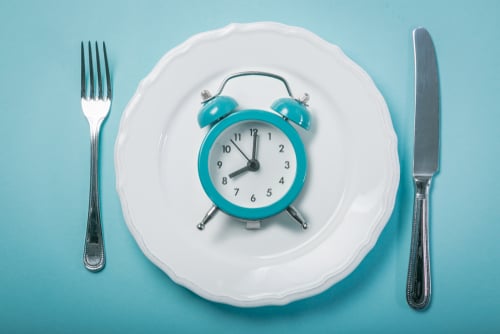
A new form of weight loss is exploding around the world called “Intermittent Fasting.” Now, most people have experienced some form of fasting as it holds an important place in most spiritual practices. Religious fasting traditions include; Judaism during Yom Kippur, Islam during Ramadan, Christianity during Lent, and Buddhism’s one meal a day. It’s a way to temporarily give up what distracts you and replace it with prayer.
But science is now demonstrating that fasting can benefit your body and mind just as much as your soul. Intermittent fasting has shown to be a proven and effective way to lose weight, plus it may also lower your risk for chronic disease, stimulate new brain cells, and overall improve your health.1
WHAT IS INTERMITTENT FASTING?
Intermittent fasting is not about what you eat, but when, and it’s exactly what it sounds like. Sometimes you eat and sometimes you don’t. No foods are explicitly forbidden during the eating window, but some people choose to do the keto carb restricting diets to accelerate their weight loss. Below are several different methods you can try.
The 12/12 Method
The 12/12 Method is pretty simple, abstain from eating for 12 consecutive hours (including your sleeping hours) and only eat within the window of the other 12. It’s entirely up to you which 12 hours you decide to eat and fast. This is the easiest method and a good option for beginners because the fasting timeframe is relatively short. Choosing to fast between 8 pm and 8 am means you’d never have to skip a meal. How easy is that?! But be forewarned, 12/12 has the least impact on your waistline and overall health.
The 16/8 Method
The 16/8 Method involves abstaining from eating for 16 consecutive hours (including your sleeping hours) and only allowing yourself to eat during the other 8. Just like 12/12, the hours you decide to fast and eat are totally up to you. This method is excellent to try if 12/12 wasn’t much of a challenge and didn’t give you the amount of weight loss you desired. If you can comfortably forgo breakfast, the hours between noon and 8 pm might work best. If bacon and eggs are your things, try from 9 am to 5 pm. 16/8 is the most popular method because people find it’s not too difficult to sustain and yields much better results than the 12/12 method.
The 5/2 Method
The 5/2 Method involves restricting your caloric consumption to 500 calories for two non-consecutive days in one week and eating regular meals for the other five. For example, if you want to keep your weekends unrestricted, try eating normally on Tuesday, Wednesday, Friday, Saturday, and Sunday and fasting Monday and Thursday. Again, the days you choose to fast are totally up to you. Most people find that this is the most challenging method to sustain.
Whichever method you choose, you can drink coffee, tea, or water. Avoid all other beverages, including those that have artificial sweeteners, like diet soda, as they can break your fast. During the hours that you are not fasting, be sure to take your usual dietary supplements. You don’t want to lose momentum when it comes to supplements. And although there are no specific food restrictions during your eating periods, keep to nutritious, healthy food choices. Going overboard on high-calorie snacks and meals will add additional calories and make your fasting efforts unfruitful.
THE BENEFITS TO BODY, MIND & WAISTLINE
Intermittent fasting’s growing popularity is prompting many new studies and research showing its various benefits.
For the body, limiting the number of hours you eat to between 8 and 12 can reduce oxidative stress, which decreases inflammation and the risk of chronic disease.2
For the mind, studies show that intermittent fasting enhances the brain’s functionality and bolsters the brain’s resistance to stress and illness.
And for the waistline, a review of 40 different studies found that intermittent fasting was a valid and effective form of weight loss with participants losing 7-11 pounds on average over a ten-week time frame.3
IS IT RIGHT FOR YOU?
Intermittent fasting may not be the best weight loss choice for everyone. Women should ease into the practice as it may interrupt their menstrual cycles. People who have low body weight, low blood pressure, or have diabetes should speak to their doctors before trying intermittent fasting. Avoid intermittent fasting if you are either pregnant or breastfeeding.
Adding a probiotic when you’re fasting is a great idea. It will help keep your gut flora in balance while your stomach is empty. A 2017 study found that combining intermittent fasting with probiotics can have an impact on reducing inflammation and boosting the immune system and overall detoxification.4
Citations:
1. “Short-Term Fasting Induces Profound Neuronal Autophagy”. 2019. Autophagy. https://www.tandfonline.com/doi/full/10.4161/auto.6.6.12376.
2. Mattson, Mark P., Keelin Moehl, Nathaniel Ghena, Maggie Schmaedick, and Aiwu Cheng. 2018. “Intermittent Metabolic Switching, Neuroplasticity And Brain Health”. Nature Reviews Neuroscience 19 (2): 80-80. Springer Science and Business Media LLC. doi:10.1038/nrn.2017.156.
3. “Diet Review: Intermittent Fasting For Weight Loss”. 2018. The Nutrition Source. https://www.hsph.harvard.edu/nutritionsource/healthy-weight/diet-reviews/intermittent-fasting/.
4. Blythe, Jerry, and Stefania Pacini. 2017. “Case Report: Intermittent Fasting And Probiotic Yogurt Consumption Are Associated With Reduction Of Serum Alpha-N-Acetylgalactosaminidase And Increased Urinary Excretion Of Lipophilic Toxicants”. Semanticscholar.Org. https://www.semanticscholar.org/paper/Case-report%3A-intermittent-fasting-and-probiotic-are-Blythe-Pacini/3ca37a9c5c433ba22553de43ddfb776f6e08128e.
